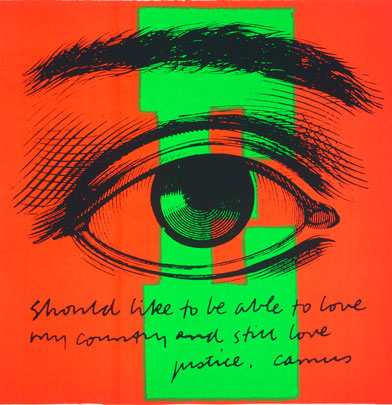Someday is Now: The Art of Corita Kent
January 31 – April 19, 2015
New ideas are bursting all around and all this comes into you and is changed by you.
About the Artist
Corita Kent (1918-1986) was a pioneering, Los Angeles-based artist and designer. For over three decades, Corita, as she is commonly referred to, experimented in printmaking, producing a prodigious and groundbreaking body of work that combines faith, activism, and teaching with messages of acceptance and hope. Her vibrant, Pop-inspired prints from the 1960s pose philosophical questions about racism, war, poverty, and religion and remain iconic symbols of that period in American history. Bringing together artwork from across Corita’s entire career, Someday Is Now reveals the impassioned energy of this artist, educator, and activist.
A Sister of the Immaculate Heart of Mary, Corita taught at the Art Department at Immaculate Heart College from 1947 through 1968. At IHC, Corita developed her own version of Pop art, mixing bright, bold imagery with provocative texts pulled from a range of secular and religious sources, including street signs, scripture, poetry, philosophy, advertising, and pop song lyrics. She used printmaking as a populist medium to communicate with the world, and her avant-garde designs appeared widely as billboards, book jackets, illustrations, and posters. By the mid-1960s Corita and IHC’s art department had become legendary, frequently bringing such guests as John Cage, Charles and Ray Eames, Buckminster Fuller, Saul Bass, and Alfred Hitchcock. Dubbed the “joyous revolutionary” by artist Ben Shahn, Corita lectured extensively, appeared on television and radio talk shows across the country, and on the cover of Newsweek in 1967.
As a teacher, Corita inspired her students to discover new ways of experiencing the world. She asked them to see with fresh eyes through the use of a “finder,” an empty 35mm slide mount that students looked through to frame arresting compositions and images. Seeking out revelation in the everyday, students explored grocery stores, car dealerships, and the streets of Hollywood. As Corita’s friend, theologian Harvey Cox, noted, “Like a priest, a shaman, a magician, she could pass her hands over the commonest of the everyday, the superficial, the oh-so-ordinary, and make it a vehicle of the luminous, the only, and the hope filled.”
Corita's Teaching
In the 1960s, during a drive across the country, Andy Warhol famously said, “Once you got Pop you could never see a sign the same way again,” reflecting on how pop was everywhere. And that, “once you thought Pop, you could never see America the same way again.” Like Warhol, Corita Kent was enamored with everyday objects that most people take for granted, things people see without really seeing.
In 1979, Corita asked her friend and former student Jan Steward to collaborate on a book that would capture Corita’s work as an educator. It took 13 years for the book, Learning By Heart, to be published, six years after Corita’s death at the age of 68. This “workbook” as Steward calls it is not only a manual to learn how to draw and paint, it is also a guide to being creative and to seeing the world anew.
Use the assignments below to experience Corita’s teachings first-hand. All of the content, assignments, and quotes come directly from Steward and Corita’s book. Corita’s students recorded their source material and inspirations in a sense diary, and it became a creative tool for making art. Share your assignments with us using hashtag #CoritaKent.
Looking Assignment: Nothing is the Same
- Take something in nature—two dandelions—and look at them for five minutes. List how they are different from each other. Take two leaves from the same tree and do the same thing. Take two peas from the same pod and do the same thing.
- Nothing is the same. No thing is the same. Everything is itself and one of a kind.
- After doing this for a week, look back at these pairs of things again and make a new list. You will find more differences because you have been exercising your powers of observation.
- Genius is looking at things in an unhabitual way.
Work in areas where you are unsure, in places you’ve not been before.
Sources Assignment: Market Trip
- The next time you go to the market take a notebook and write down fifty things about the trip—on the way, there, in the parking lot, and coming home.
- List ten projects for which sources could be found at the market, not necessarily related to the buying and selling of food.
- Make three- or four-line poems from the promises on the food labels.
Structure Assignment: Kitchen Tools
- Carefully lay out some kitchen tools on a clean white piece of paper or on some beautiful textile.
- Look at the forms of the tools and see how their use evolved.
List, as Charles and Ray Eames did, the requirements or properties of the object. - See them as works of art.
- Read the Badger’s dissertation in The Once and Future King by T.H. White for another viewpoint on how needs and requirements define the final structure of an object.


